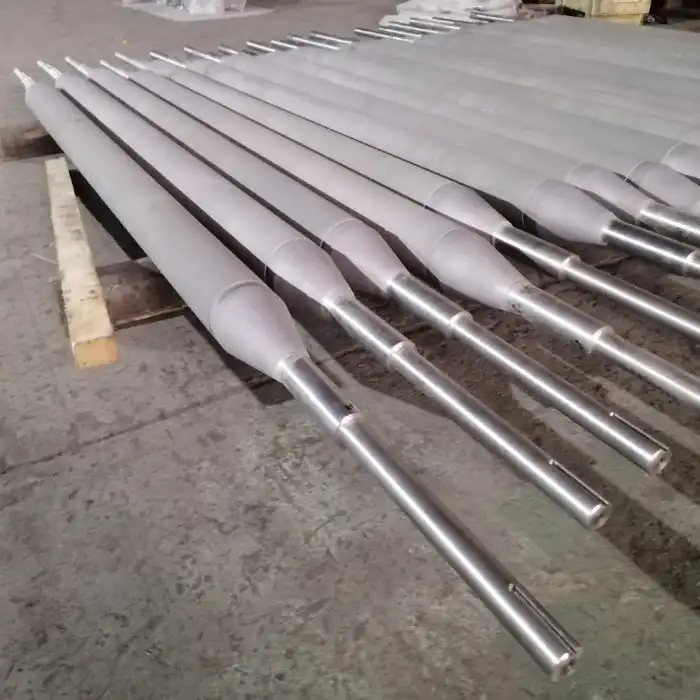Thermal Shock Effects on Furnace Rolls
Temperature Gradients and Material Expansion
Thermal shock is a phenomenon that occurs when furnace rolls experience sudden and drastic temperature changes, leading to steep temperature gradients within the material structure. This rapid temperature fluctuation creates differential thermal expansion, meaning that different parts of the furnace roll expand or contract at different rates. Such gradients can lead to internal stresses that may surpass the material's inherent strength limits, which in turn can cause significant mechanical failure.
When a furnace roll is exposed to sudden heating or cooling, the outer surface of the roll is typically subjected to faster cooling compared to the interior. This is due to the fact that the surface of the roll is in direct contact with the surrounding environment, which often has a lower temperature. On the other hand, the inner core remains relatively insulated, retaining more heat. As a result, the outer layer of the roll contracts more rapidly than the interior, generating tensile stresses on the surface of the roll. Meanwhile, the interior experiences compressive stresses due to the slower contraction rate. These tensile stresses at the surface and compressive stresses in the core can initiate microcracks and eventually lead to the failure of the roll.
Surface Cracking and Spalling
One of the most immediate and visible consequences of thermal shock on furnace rolls is surface cracking. When the furnace roll undergoes rapid cooling or heating, the outer surface contracts or expands at a different rate than the interior, resulting in tensile stresses that are focused on the surface. These stresses can cause microscopic fissures to form, which initially may not be visible but gradually grow over time with repeated cycles of thermal shock.
As the material continues to experience temperature fluctuations, the cracks propagate deeper into the roll’s surface, weakening its structural integrity. The cracks can eventually reach a critical size where they cause spalling, a phenomenon where pieces of the roll’s surface material begin to flake off. Spalling is especially problematic because it not only compromises the roll's mechanical strength but also impacts the quality of the processed materials. As the roll surface deteriorates, the material being processed could come into direct contact with the compromised surface, leading to defects such as uneven surface finishes, contamination, or dimensional inaccuracies.
Microstructural Changes
Repeated thermal shock events can alter the microstructure of the furnace roll material. In metallic rolls, this may manifest as grain boundary weakening, phase transformations, or precipitation of secondary phases. These microstructural changes can significantly affect the roll's mechanical properties, potentially reducing its strength, ductility, and resistance to wear and corrosion.
One of the primary changes that occur under thermal shock is grain boundary weakening. In metallic materials, grains are the small crystalline regions that make up the material’s structure. Grain boundaries are the interfaces between adjacent grains, and their strength is crucial for the overall integrity of the material. When a roll experiences repeated thermal shock, the differential thermal expansion between grains can cause the grain boundaries to weaken, resulting in a reduction of the material’s overall strength. Over time, these weakened boundaries become more susceptible to deformation, cracking, or even fracture, further compromising the roll’s performance.
Cyclic Stress Impact on Furnace Rolls
Fatigue Initiation and Propagation
Cyclic stress in furnace rolls primarily results from the repeated loading and unloading during operation. This cyclical nature of stress application can lead to fatigue, a process where damage accumulates over time, even when the applied stresses are below the material's yield strength. Fatigue typically initiates at stress concentration points, such as surface imperfections or microstructural defects, and propagates through the material with each stress cycle.
Creep-Fatigue Interaction
In high-temperature environments, furnace rolls experience a complex interplay between creep and fatigue mechanisms. Creep, the time-dependent deformation under constant stress, becomes more pronounced at elevated temperatures. When combined with cyclic loading, it can accelerate damage accumulation through mechanisms such as grain boundary sliding and void formation. This creep-fatigue interaction often results in reduced service life compared to what would be expected from either mechanism acting alone.
Residual Stress Evolution
Cyclic stress can lead to the evolution of residual stresses within the furnace roll. Initially, these residual stresses may be beneficial, potentially improving fatigue resistance. However, over time, the redistribution and relaxation of these stresses can contribute to dimensional instability and accelerated crack growth. Understanding and managing residual stress evolution is crucial for predicting and extending the operational lifespan of furnace rolls.
Mitigating Thermal Shock and Cyclic Stress Effects
Material Selection and Design Optimization
Choosing appropriate materials and optimizing the design of furnace rolls are crucial steps in mitigating the effects of thermal shock and cyclic stress. Advanced alloys with improved thermal shock resistance, such as those containing high levels of chromium and nickel, can significantly enhance roll performance. Additionally, design features like controlled cooling channels or composite structures can help distribute thermal loads more evenly, reducing the severity of temperature gradients and associated stresses.
Operational Strategies and Process Control
Implementing careful operational strategies and precise process control can greatly reduce the impact of thermal shock and cyclic stress on furnace rolls. This may include gradual heating and cooling procedures, optimized roll rotation speeds, and balanced load distribution across the roll surface. Advanced monitoring systems can provide real-time data on temperature distributions and stress levels, allowing operators to make informed decisions and adjust parameters to minimize damaging conditions.
Surface Treatments and Coatings
Applying specialized surface treatments and coatings can enhance the resistance of furnace rolls to thermal shock and cyclic stress. Techniques such as shot peening or laser surface hardening can induce beneficial compressive stresses in the surface layer, improving fatigue resistance. Ceramic or cermet coatings can provide an additional thermal barrier, reducing the severity of temperature fluctuations experienced by the base material. These surface modifications can significantly extend the service life of furnace rolls in demanding high-temperature applications.
In conclusion, understanding and addressing the effects of thermal shock and cyclic stress on furnace rolls is essential for optimizing their performance and longevity in industrial settings. By implementing a combination of advanced materials, intelligent design, careful operational practices, and innovative surface treatments, manufacturers and operators can significantly enhance the resilience of these critical components. As industries continue to push the boundaries of high-temperature processes, the development of more robust furnace rolls will play a crucial role in improving efficiency and reliability. For more information on how to optimize your furnace roll selection and maintenance strategies, please contact our team of experts at info@welongpost.com.
References
- Influence of Warm and Cold Rolling on Surface Quality and Microstructure of High Silicon Iron Sheet. Metallurgical and Materials Transactions B, 2025.
- Effects of Boron on Microstructure and Mechanical Properties of Fe-6.5 wt.%Si Alloy Fabricated by Directional Solidification. Intermetallics, 2013.
- Strain-Softening Behavior of an Fe-65 wt.%Si Alloy during Warm Deformation and its Applications. Materials Science and Engineering A, 2011.
- Deformation Twinning in an Fe-6.5 wt.% Si Alloy with Columnar Grains during Intermediate Temperature Compression. Materials Science and Engineering A, 2012.
- Tensile Properties of Strip Casting 6.5 wt.% Si Steel at Elevated Temperatures. Materials Science and Engineering A, 2015.
- Solidification Structure and Crystallographic Texture of Strip Casting 3 wt.% Si Non-Oriented Silicon Steel. Materials Characterization, 2011.




